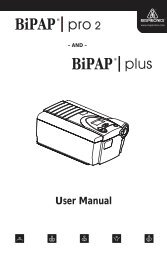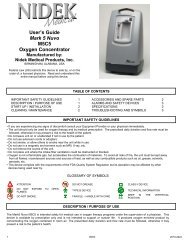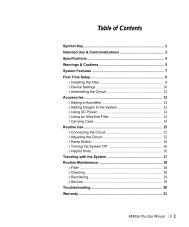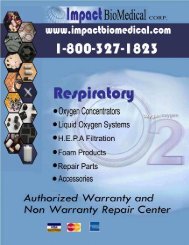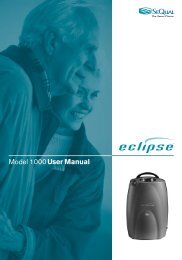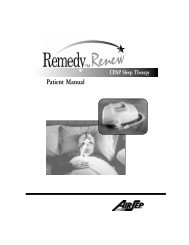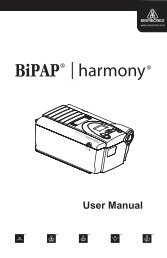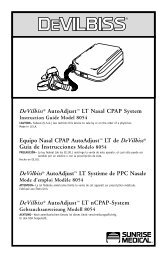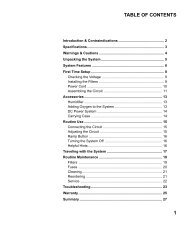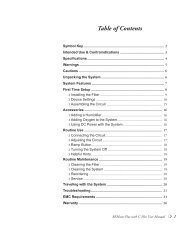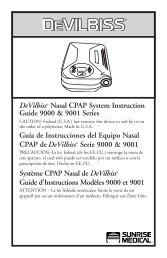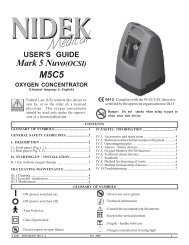for NewLife 8-Liter Oxygen Concentrator - Air Liquide Australia
for NewLife 8-Liter Oxygen Concentrator - Air Liquide Australia
for NewLife 8-Liter Oxygen Concentrator - Air Liquide Australia
Create successful ePaper yourself
Turn your PDF publications into a flip-book with our unique Google optimized e-Paper software.
Patient Manual<br />
<strong>for</strong> <strong>NewLife</strong> 8-<strong>Liter</strong><br />
<strong>Oxygen</strong> <strong>Concentrator</strong><br />
includes<br />
<strong>Oxygen</strong> Monitor, Dual Flow, and<br />
Pediatric/Low Flow Options
TABLE OF CONTENTS<br />
<strong>Air</strong>Sep ® <strong>NewLife</strong> ® Intensity<br />
<strong>Oxygen</strong> <strong>Concentrator</strong><br />
Why Your Physician Prescribed <strong>Oxygen</strong> 2<br />
What Is an <strong>Oxygen</strong> <strong>Concentrator</strong> 2<br />
Important Safety Rules 4<br />
How to Operate Your <strong>Oxygen</strong> <strong>Concentrator</strong> 6<br />
Filters 10<br />
<strong>Oxygen</strong> Without Humidifier 10<br />
<strong>Oxygen</strong> With Humidifier 11<br />
Nasal Cannula 12<br />
Proper Setting of <strong>Oxygen</strong> Flowmeter 13<br />
Cleaning, Care, and Proper Maintenance 14<br />
Cabinet 14<br />
Filters 15<br />
Reserve <strong>Oxygen</strong> Supply 16<br />
Troubleshooting 16<br />
Product Specifications 19<br />
Classification 21<br />
Symbols 22
TABLE OF CONTENTS<br />
<strong>Oxygen</strong> Monitor Option<br />
Function of the <strong>Oxygen</strong> Monitor A-2<br />
Alarm Signal A-2<br />
Dual Flow and Pediatric/<br />
Low Flow Options<br />
Dual Flow Application B-2<br />
Pediatric/Low Flow Application B-3
<strong>Air</strong>Sep ® <strong>NewLife</strong> ® Intensity <strong>Oxygen</strong> <strong>Concentrator</strong><br />
This Patient Manual will acquaint you with <strong>Air</strong>Sep’s <strong>NewLife</strong> <strong>Oxygen</strong> <strong>Concentrator</strong> with Intensity/<br />
8-<strong>Liter</strong> option. Make sure you read and understand all the in<strong>for</strong>mation contained in this guide be<strong>for</strong>e<br />
you operate your unit. Should you have any questions, your Equipment Provider will be happy to<br />
answer them <strong>for</strong> you.<br />
In the event of an alarm or if you are experiencing any signs of patient discom<strong>for</strong>t,<br />
consult your Equipment Provider and/or your physician immediately.<br />
This unit is not to be used <strong>for</strong> or with any life-supporting applications. Geriatric,<br />
pediatric, or any other patient unable to communicate discom<strong>for</strong>t while using this<br />
machine may require additional monitoring. Consult your physician immediately if<br />
you are experiencing any signs of patient discom<strong>for</strong>t.<br />
1<br />
This device manufactures high purity oxygen, which promotes rapid burning. Do not<br />
allow smoking or open flames within 5 feet of: (1) this device or (2) any oxygencarrying<br />
accessory. Use no oil, grease, or petroleum-based products on or near the<br />
unit. Disconnect the power cord from the electrical outlet be<strong>for</strong>e you clean or service<br />
the unit.<br />
NEWLIFE INTENSITY OXYGEN CONCENTRATOR
Why Your Physician Prescribed <strong>Oxygen</strong><br />
Many people today suffer from a variety of heart, lung, and other respiratory diseases. A significant<br />
number of these patients can benefit from supplemental oxygen therapy <strong>for</strong> respiratory care at home,<br />
in the hospital, or at a medical facility.<br />
<strong>Oxygen</strong> is a gas that makes up 21% of the room air we breathe. Our bodies depend on a steady supply<br />
to function properly. Your physician has prescribed supplemental oxygen therapy because your body<br />
is not able to get enough oxygen from room air. <strong>Oxygen</strong> is a non-addictive drug, and your physician<br />
prescribed a flow sufficient to improve your condition.<br />
Please keep in mind that unauthorized oxygen therapy can be dangerous. You must seek medical<br />
advice be<strong>for</strong>e you use this unit. The Equipment Provider who supplies your oxygen equipment will<br />
demonstrate how to set the prescribed flow rate.<br />
2<br />
It is very important to follow the prescribed level of oxygen flow. Do not increase or<br />
decrease the flow until you first consult your physician.<br />
What Is an <strong>Oxygen</strong> <strong>Concentrator</strong><br />
<strong>Oxygen</strong> concentrators were introduced in the mid-1970s and have become the most convenient,<br />
reliable source of supplemental oxygen available today. Without an oxygen concentrator, the average<br />
patient would require a delivery of 12 bottles/cylinders of oxygen each month. Your oxygen<br />
concentrator produces all the oxygen you need, with no deliveries required.
The air we breathe contains approximately 21% oxygen, 78% nitrogen, and 1% other gases.<br />
In the <strong>NewLife</strong> Intensity unit, room air passes through a regenerative adsorbent material called<br />
molecular sieve. This material separates the oxygen from the nitrogen and other gases. The result is<br />
a constant supply of concentrated high purity supplemental oxygen that is delivered to the patient.<br />
There is never a danger of depleting the oxygen in a room when you use your <strong>NewLife</strong><br />
Intensity unit.<br />
3<br />
NEWLIFE INTENSITY OXYGEN CONCENTRATOR
Important Safety Rules<br />
Carefully review and familiarize yourself with the following important safety in<strong>for</strong>mation about the<br />
<strong>NewLife</strong> Intensity <strong>Oxygen</strong> <strong>Concentrator</strong>:<br />
In the event of an alarm or if you are experiencing any signs of patient discom<strong>for</strong>t,<br />
consult your Equipment Provider and/or your physician immediately.<br />
This unit is not to be used <strong>for</strong> or with any life-supporting applications. Geriatric,<br />
pediatric, or any other patient unable to communicate discom<strong>for</strong>t while using this<br />
machine may require additional monitoring. Consult your physician immediately if<br />
you are experiencing any signs of patient discom<strong>for</strong>t.<br />
4<br />
Do not leave a nasal cannula under bed coverings or chair cushions. If the unit is<br />
turned on but not in use, the oxygen will make the material flammable. Set the I/0<br />
power switch to the 0 (off) position when the <strong>NewLife</strong> Intensity unit is not in use.<br />
Electrical shock hazard. Do not remove covers while the unit is plugged in. Only<br />
your Equipment Provider should remove the covers.
This device manufactures high purity oxygen, which promotes rapid burning. Do not<br />
allow smoking or open flames within 5 feet of: (1) this device or (2) any oxygencarrying<br />
accessory. Use no oil, grease, or petroleum-based products on or near the<br />
unit. Disconnect the power cord from the electrical outlet be<strong>for</strong>e you clean or service<br />
the unit.<br />
Do not use extension cords with this unit.<br />
<strong>Air</strong>Sep recommends an alternate source of supplemental oxygen in the event of a<br />
power outage, alarm condition, or mechanical failure. Consult your physician or<br />
Equipment Provider <strong>for</strong> the type of reserve system required.<br />
5<br />
Federal law restricts this device to sale by or on order of a physician. Use unit in<br />
accordance with the manufacturer’s Patient Manual.<br />
NEWLIFE INTENSITY OXYGEN CONCENTRATOR
How to Operate Your <strong>Oxygen</strong> <strong>Concentrator</strong><br />
First, become familiar with the important parts of your <strong>NewLife</strong> Intensity<br />
<strong>Oxygen</strong> <strong>Concentrator</strong> (Figures 1a and 1b).<br />
A. On/Off (I/0) Power Switch:<br />
Starts and stops the operation of the unit.<br />
D<br />
B. Circuit Breaker Reset Button:<br />
Resets the unit after electrical overload shutdown.<br />
C<br />
C. Digital Hour Meter:<br />
B<br />
Records the unit’s total hours of operation.<br />
A<br />
D. Flowmeter/Adjustment Knob (Primary on Dual Option):<br />
Controls and indicates the oxygen flow rate in liters per minute<br />
(lpm). Main flowmeter (left side) on units with dual flow option.<br />
E. <strong>Oxygen</strong> Outlet (Primary on Dual Option):<br />
Provides connections <strong>for</strong> a humidifier (if required), cannula, or<br />
catheter. On units with dual flow option, controlled by primary<br />
flowmeter.<br />
F. Top and Side Handles:<br />
Enables convenience in carrying the unit.<br />
G. Operating Instructions:<br />
Explains procedures to operate the unit.<br />
H. Secondary Flowmeter (Dual Option):<br />
Flowmeter (right side) on units with dual flow option.<br />
I. Secondary <strong>Oxygen</strong> Outlet (Dual Option):<br />
<strong>Oxygen</strong> outlet (right side) on units with dual flow option. Controlled<br />
by secondary flowmeter.<br />
E<br />
F<br />
Figure 1a<br />
D<br />
E<br />
G<br />
F<br />
G<br />
Dual Flow Option<br />
H<br />
I<br />
6
J. <strong>Air</strong> Intake Gross Particle Filter:<br />
Prevents dust and other airborne particles from entering the unit.<br />
K. Storage Pocket:<br />
Handy accessory pocket with Velcro attachments to hold user<br />
manual, extra air intake filter, and oxygen adapter.<br />
L. Power Cord:<br />
Allows connection of unit into an electrical outlet.<br />
L<br />
J<br />
Do not use extension cords with this unit.<br />
K<br />
1. Locate the unit near an electrical outlet in the room where you spend<br />
most of your time.<br />
7<br />
2. Position the unit away from curtains or drapes, hot air registers, heaters,<br />
and fireplaces. Be certain to place the unit so all sides are at least 12<br />
inches away from a wall or other obstruction. Do not place the unit in a<br />
confined area.<br />
Figure 1b<br />
3. Turn the unit so that the operating controls are within easy reach and the air intake on the back of the<br />
unit is not obstructed.<br />
4. Connect oxygen accessories such as a humidifier (if required), cannula, catheter, and/or extension<br />
tubing to the oxygen outlet.<br />
5. Remove the power cord completely from around the concentrator, if wrapped around (Figure 1b).<br />
NEWLIFE INTENSITY OXYGEN CONCENTRATOR
6. Insert the power cord into the electrical outlet.<br />
7. Locate the power switch on the front of the unit, and switch it to<br />
the I position (on). (Figure 2.)<br />
A battery-operated audible alarm must loudly sound <strong>for</strong> a 5-second<br />
test to indicate a good battery and alarm.<br />
On/Off<br />
Power Switch<br />
If the alarm is weak or does not sound at all,<br />
consult your Equipment Provider immediately.<br />
The standard <strong>NewLife</strong> Intensity <strong>Oxygen</strong><br />
<strong>Concentrator</strong> accommodates high pressure/high<br />
flow prescriptions from 2 to 8 lpm.<br />
Figure 2 8<br />
8. Dual Flow and High Flow Applications: Set the flowmeter<br />
adjustment knob(s) to the prescribed lpm, in any combination<br />
of flows up to a total of 8 lpm <strong>for</strong> 8 liter dual flow units.<br />
(Figure 3).<br />
or<br />
Pediatric/Low Flow Applications: See page B-3 <strong>for</strong> details.<br />
Figure 3<br />
The concentrator is now ready <strong>for</strong> use.
9. To turn the concentrator off, press the I/0 switch to the 0 position.<br />
Always operate the unit in an upright position.<br />
10. If the <strong>NewLife</strong> Intensity unit fails to operate properly, refer to the Troubleshooting<br />
section <strong>for</strong> a list of probable causes and solutions.<br />
9<br />
For easier reference, store this Patient Manual and the additional air<br />
intake gross particle filter (if provided) in the pocket.<br />
NEWLIFE INTENSITY OXYGEN CONCENTRATOR
Filters<br />
<strong>Air</strong> enters the <strong>NewLife</strong> Intensity unit through an air intake gross particle filter<br />
located on the back of the oxygen concentrator. This filter removes dust<br />
particles and other impurities from the air. Be<strong>for</strong>e you operate the <strong>NewLife</strong><br />
Intensity unit, make sure this filter is clean and positioned correctly (Figure<br />
4).<br />
The supplemental oxygen produced by the <strong>NewLife</strong> Intensity unit receives<br />
additional filtration from a product filter located within the oxygen<br />
concentrator. Your Equipment Provider per<strong>for</strong>ms maintenance on the product<br />
filter in addition to other maintenance on the unit.<br />
The use of some oxygen administration accessories not<br />
specified <strong>for</strong> use with this oxygen concentrator may impair<br />
its per<strong>for</strong>mance.<br />
Figure 4<br />
10<br />
<strong>Oxygen</strong> Without Humidifier<br />
1. If your physician did not prescribe a humidifier, connect the oxygen<br />
tubing directly to the unit’s oxygen outlet. A separate outlet fitting is<br />
supplied <strong>for</strong> this type of connection (Figure 5).<br />
Figure 5
<strong>Oxygen</strong> With Humidifier<br />
Follow these steps if your physician prescribed an oxygen humidifier as part<br />
of your therapy:<br />
1. Remove or unscrew the reservoir bottle from the humidifier. (If you<br />
have a pre-filled unit, do not per<strong>for</strong>m this step. Proceed directly to<br />
step 4.)<br />
2. Fill the reservoir with cool or cold water (distilled water is preferred)<br />
to the fill line indicated on the bottle. DO NOT OVERFILL.<br />
3. Screw the reservoir bottle back together.<br />
4. On the top of the humidifier, turn the threaded nut counterclockwise<br />
while you connect the humidifier to the oxygen outlet, and tighten<br />
securely (Figure 6).<br />
5. Connect oxygen tubing from the cannula or catheter to the humidifier<br />
outlet fitting (Figure 7).<br />
Figure 6<br />
11<br />
The use of certain humidifiers not specified <strong>for</strong> use<br />
with this oxygen concentrator may impair its<br />
per<strong>for</strong>mance.<br />
Figure 7<br />
NEWLIFE INTENSITY OXYGEN CONCENTRATOR
To Equipment Provider: The following<br />
humidifier bottle is recommended <strong>for</strong> use with<br />
the <strong>NewLife</strong> Intensity <strong>Oxygen</strong> <strong>Concentrator</strong>:<br />
•<strong>Air</strong>Sep Part No. HU003-1.<br />
Nasal Cannula<br />
Your physician has prescribed either a nasal cannula or catheter (Figure 8).<br />
In most cases, the manufacturer has already connected the oxygen supply<br />
tubing to the cannula or catheter. If not, follow the manufacturer’s<br />
instructions <strong>for</strong> proper connection. Connect the oxygen tubing to the<br />
oxygen outlet adapter or humidifier.<br />
12<br />
To Equipment Provider: The following oxygen<br />
administration accessories are recommended <strong>for</strong> use with<br />
the <strong>NewLife</strong> Intensity <strong>Oxygen</strong> <strong>Concentrator</strong>:<br />
•Nasal Cannula with 7 feet of tubing: <strong>Air</strong>Sep Part No. CU002-1.<br />
•<strong>Oxygen</strong> Outlet Adapter: <strong>Air</strong>Sep Part No. F0025-1.<br />
Figure 8
Proper Setting of <strong>Oxygen</strong> Flowmeter<br />
To set the proper flow of supplemental oxygen, turn the flowmeter<br />
adjustment knob left or right until the ball inside the flowmeter centers<br />
on the flow line number prescribed by your physician (Figure 9).<br />
To view the flowmeter at the proper angle, note that the back line and the<br />
front numbered line must give the appearance of just one line.<br />
It is very important to follow the prescribed level of<br />
oxygen flow. Do not increase or decrease the flow until<br />
you first consult your physician.<br />
Normally, you should not need to adjust the flowmeter<br />
on your unit. If you turn the flowmeter adjustment knob<br />
clockwise, you will decrease and can shut off the flow of<br />
oxygen from your unit. For your convenience, the<br />
flowmeter is marked in 1/2 lpm increments from 2 to 8<br />
lpm flow settings. For units with the pediatric flowmeter<br />
option, the flowmeter is marked in 1/8 lpm increments<br />
<strong>for</strong> flow settings up to 2 lpm.<br />
Figure 9<br />
13<br />
NEWLIFE INTENSITY OXYGEN CONCENTRATOR
Cleaning, Care, and Proper Maintenance<br />
Cabinet<br />
Disconnect the power cord from the electrical<br />
outlet be<strong>for</strong>e you clean the cabinet.<br />
Do not use liquid directly on the unit. Do not use<br />
any petroleum-based solvents or cleaning agents.<br />
Figure 10<br />
14<br />
Clean the cabinet and power cord only with a mild<br />
household cleaner applied with a damp cloth or<br />
sponge, and then wipe them dry (Figure 10).
Filters<br />
Do not operate the unit without the air intake gross particle<br />
filter in place.<br />
On a weekly basis, wash the air intake gross particle filter, located on the<br />
back of the unit. Your Equipment Provider may advise you to clean it<br />
more often depending on your operating conditions.<br />
Follow these steps to properly clean the air intake gross particle filter:<br />
1. Remove the filter and wash in a warm solution of soap and water<br />
(Figure 11).<br />
2. Rinse the filter thoroughly, and remove excess water with a soft<br />
absorbent towel.<br />
3. Replace the filter.<br />
Figure 11<br />
15<br />
NEWLIFE INTENSITY OXYGEN CONCENTRATOR
<strong>Air</strong>Sep does not recommend the sterilization of this equipment.<br />
Reserve <strong>Oxygen</strong> Supply<br />
Your Equipment Provider should provide or suggest an alternative source <strong>for</strong> supplemental oxygen<br />
therapy in case there is a mechanical failure or a power outage. During a power outage, alarm condition,<br />
or mechanical failure, use your reserve oxygen supply (if provided), and consult your Equipment<br />
Provider immediately.<br />
16<br />
Troubleshooting<br />
If your <strong>NewLife</strong> Intensity <strong>Oxygen</strong> <strong>Concentrator</strong> fails to operate properly, consult your Equipment<br />
Provider, and then refer to the troubleshooting chart on the following pages <strong>for</strong> probable causes and<br />
solutions.
Do not attempt any maintenance other than the possible solutions listed below.<br />
If you cannot get the unit to operate, connect your cannula or catheter to the reserve supplemental<br />
oxygen supply (if provided).<br />
Problem<br />
Unit does not operate. Power<br />
failure condition causes a<br />
continuous alarm to sound.<br />
Probable<br />
Cause<br />
Power cord not connected<br />
into electrical outlet.<br />
Solution<br />
Check power cord plug at the electrical outlet<br />
<strong>for</strong> a proper connection.<br />
17<br />
No<br />
power at electrical outlet.<br />
Check power source, wall<br />
circuit breaker in-house.<br />
switch, fuse, or<br />
<strong>Oxygen</strong> concentrator circuit<br />
breaker is activated.<br />
P ress ( Do not hold in)<br />
the circuit breaker<br />
reset button on the front of the unit.<br />
Contact your Equipment Provider <strong>for</strong> service.<br />
NEWLIFE INTENSITY OXYGEN CONCENTRATOR
18<br />
roblem<br />
P<br />
e<br />
Caus<br />
robable<br />
P<br />
n<br />
Solutio<br />
flow.<br />
oxygen<br />
imited<br />
L -<br />
humid<br />
obstructed<br />
or<br />
Dirty<br />
bottle.<br />
ifier<br />
from<br />
used)<br />
(if<br />
bottle<br />
humidifier<br />
the<br />
Remove<br />
clean<br />
restored,<br />
is<br />
flow<br />
If<br />
outlet.<br />
oxygen<br />
the<br />
bottle.<br />
humidifier<br />
new<br />
a<br />
with<br />
replace<br />
or<br />
cannula,<br />
nasal<br />
Defective<br />
oxygen<br />
and/or<br />
catheter,<br />
tube.<br />
delivery<br />
from<br />
catheter<br />
or<br />
cannula<br />
nasal<br />
Remove<br />
restored,<br />
is<br />
flow<br />
proper<br />
If<br />
tubing.<br />
oxygen<br />
catheter.<br />
or<br />
cannula<br />
new<br />
with<br />
replace<br />
outlet<br />
oxygen<br />
at<br />
tubing<br />
delivery<br />
Disconnect<br />
restored,<br />
is<br />
flow<br />
proper<br />
If<br />
unit).<br />
of<br />
(front<br />
or<br />
kinks<br />
<strong>for</strong><br />
tubing<br />
oxygen<br />
check<br />
needed.<br />
if<br />
Replace<br />
obstructions.<br />
the<br />
in<br />
collects<br />
Condensation<br />
use<br />
you<br />
when<br />
tubing<br />
oxygen<br />
bottle.<br />
humidifier<br />
the<br />
ventilated.<br />
properly<br />
not<br />
Unit<br />
operating<br />
Elevated<br />
temperature.<br />
from<br />
away<br />
positioned<br />
is<br />
unit<br />
sure<br />
Make<br />
heaters,<br />
registers,<br />
air<br />
hot<br />
drapes,<br />
or<br />
curtains<br />
unit<br />
the<br />
place<br />
to<br />
certain<br />
Be<br />
fireplaces.<br />
and<br />
from<br />
away<br />
inches<br />
12<br />
least<br />
at<br />
are<br />
sides<br />
all<br />
so<br />
the<br />
place<br />
not<br />
Do<br />
obstruction.<br />
other<br />
or<br />
wall<br />
a<br />
area.<br />
confined<br />
a<br />
in<br />
unit<br />
water.<br />
COLD<br />
with<br />
bottle<br />
humidifier<br />
Refill<br />
tubing<br />
oxygen<br />
Allow<br />
OVERFILL.<br />
NOT<br />
DO<br />
tubing.<br />
new<br />
with<br />
replace<br />
or<br />
out,<br />
dry<br />
to
Problem<br />
Probable<br />
Cause<br />
Solution<br />
Intermittent alarm sounds<br />
one second intervals.<br />
at<br />
Equipment<br />
malfunction.<br />
Set<br />
I/<br />
0 power<br />
switch to<br />
0 position, use<br />
your reserve oxygen supply (if<br />
provided), and consult your Equipment<br />
Provider immediately.<br />
Unit does not alarm, or weak<br />
alarm sounds <strong>for</strong> 5 seconds<br />
during start-up.<br />
Weak<br />
9-volt<br />
battery.<br />
Call your Equipment<br />
9-volt battery.<br />
Provider to replace<br />
All<br />
other<br />
problems.<br />
Set<br />
I/<br />
0 power<br />
switch to the<br />
0 position,<br />
use your reserve oxygen supply (if<br />
provided), and consult your Equipment<br />
Provider immediately.<br />
19<br />
Product Specifications<br />
<strong>Oxygen</strong> Concentration:* 2-7 lpm: 92% ±3%<br />
8 lpm: 90% ±3%<br />
NEWLIFE INTENSITY OXYGEN CONCENTRATOR
Dimensions:<br />
Weight:<br />
Electrical:<br />
27.5 in. high x 16.5 in. wide x 14.5 in. deep<br />
(69.9 cm high x 41.9 cm wide x 36.8 cm deep)<br />
54 lb<br />
(24.5 kg)<br />
120 VAC, 60 Hz, 4.0 amps<br />
410 watts<br />
Two-prong polarized plug<br />
Double-insulated cabinet<br />
Export Models:<br />
220–240 VAC, 50 Hz, 2.0 amps<br />
220 VAC, 60 Hz, 2.0 amps<br />
Double-insulated cabinet<br />
20<br />
Alarms:<br />
Storage Temperature:<br />
Power failure<br />
High and low pressure<br />
Battery test<br />
Low oxygen concentration (<strong>Oxygen</strong> Monitor)<br />
-4°F to 140°F (-20°C to 60°C)<br />
* Based on an atmospheric pressure of 14.7 psia (101 kPa) at 70°F (21°C). 0459
Classification<br />
Type of protection against electric shock:<br />
Class II Protection from electric shock is achieved by DOUBLE INSULATION.<br />
Protective earthing or reliance upon installation conditions are not required.<br />
Degree of protection against electric shock:<br />
Type B Equipment providing a particular degree of protection against electric shock,<br />
particularly regarding:<br />
1) allowable leakage current;<br />
2) reliability of protective earth connection (if present).<br />
Not intended <strong>for</strong> direct cardiac application.<br />
Degree of protection against harmful ingress of water:<br />
Drip-proof equipment - IPX1.<br />
Equipment provided with an enclosure preventing entry of such an amount of<br />
falling liquid as might interfere with the satisfactory and safe operation of the<br />
equipment.<br />
Method of cleaning and infection control allowed:<br />
Please refer to the Maintenance section in the <strong>NewLife</strong> Intensity Service Manual.<br />
Degree of safety of application in the presence of flammable anesthetic gases:<br />
Equipment not suitable <strong>for</strong> such application.<br />
Mode of operation:<br />
Continuous duty.<br />
21<br />
NEWLIFE INTENSITY OXYGEN CONCENTRATOR
Symbols<br />
Symbols are frequently used on equipment in preference to words with the intention of lessening any<br />
possibility of misunderstanding caused by language differences. Symbols can also permit easier<br />
comprehension of a concept within a restricted space.<br />
The following table is a list of symbols and definitions used with the <strong>NewLife</strong> Intensity <strong>Oxygen</strong><br />
<strong>Concentrator</strong>. These symbols are referenced from the appropriate International Electrotechnical<br />
Commission (IEC) standards:<br />
IEC<br />
Symbol Publication Description<br />
!<br />
0<br />
787-02-02 Type B Equipment<br />
348 Attention, consult ACCOMPANYING DOCUMENTS<br />
417-5008 Off (power: disconnection from the mains)<br />
22<br />
417-5007 On (power: connection to the mains)<br />
417-5032 Alternating current<br />
417-5172 Class II Equipment<br />
IPX1<br />
529 Protected against dripping water
<strong>Oxygen</strong> Monitor Option<br />
The following in<strong>for</strong>mation will acquaint you with the <strong>Oxygen</strong> Monitor option <strong>for</strong> the <strong>NewLife</strong> Intensity<br />
<strong>Oxygen</strong> <strong>Concentrator</strong>. Make sure you read and understand the in<strong>for</strong>mation in this <strong>NewLife</strong> Intensity<br />
Patient Manual be<strong>for</strong>e you operate your unit. Should you have any questions, your Equipment Provider<br />
will be happy to answer them <strong>for</strong> you.<br />
In the event of an alarm or if you are experiencing any<br />
signs of patient discom<strong>for</strong>t, consult your Equipment<br />
Provider and/or your physician immediately.<br />
This unit is not to be used <strong>for</strong> or with any life-supporting<br />
applications. Geriatric, pediatric, or any other patient<br />
unable to communicate discom<strong>for</strong>t while using this<br />
machine may require additional monitoring. Consult<br />
your physician immediately if you are experiencing any<br />
signs of patient discom<strong>for</strong>t.<br />
Figure 1<br />
A-1<br />
OXYGEN MONITOR OPTION
This device manufactures high purity oxygen, which promotes rapid burning. Do not<br />
allow smoking or open flames within 5 feet of: (1) this device or (2) any oxygencarrying<br />
accessory. Use no oil, grease, or petroleum-based products on or near the<br />
unit. Disconnect the power cord from the electrical outlet be<strong>for</strong>e you clean or service<br />
the unit.<br />
Function of the <strong>Oxygen</strong> Monitor<br />
The <strong>Oxygen</strong> Monitor is a small electronic device within the <strong>NewLife</strong><br />
Intensity <strong>Oxygen</strong> <strong>Concentrator</strong> that monitors the purity of oxygen<br />
produced by the unit.<br />
Alarm Signal<br />
If oxygen purity falls below the acceptable therapeutic level, an amber<br />
OXYGEN MONITOR light on the front of the <strong>Oxygen</strong> <strong>Concentrator</strong><br />
turns on (Figure 2). If the light remains on <strong>for</strong> more than 15 minutes, an<br />
intermittent alarm sounds.<br />
A-2<br />
Amber Light<br />
Figure 2
Contact your Equipment Provider immediately if the amber OXYGEN MONITOR<br />
light remains on <strong>for</strong> more than 15 minutes.<br />
When you turn the unit on, it’s normal <strong>for</strong> the amber OXYGEN MONITOR light to<br />
turn on and remain on <strong>for</strong> up to 5 minutes.<br />
Federal law restricts this device to sale by or on order of a physician. Use unit in<br />
accordance with the manufacturer’s patient manual.*<br />
*United States Federal Requirement.<br />
A-3<br />
OXYGEN MONITOR OPTION
Dual Flow and Pediatric/Low Flow Options<br />
The following in<strong>for</strong>mation will acquaint you with the 8 liter dual flow and pediatric/low flow options<br />
<strong>for</strong> the <strong>NewLife</strong> Intensity <strong>Oxygen</strong> <strong>Concentrator</strong>. Make sure you read and understand all the in<strong>for</strong>mation<br />
in this <strong>NewLife</strong> Intensity Patient Manual be<strong>for</strong>e you operate the unit. Should you have any questions,<br />
your Equipment Provider will be happy to answer them <strong>for</strong> you.<br />
In the event of an alarm or if you are experiencing<br />
any signs of patient discom<strong>for</strong>t, consult your<br />
Equipment Provider and/or your physician<br />
immediately.<br />
B-1<br />
This unit is not to be used <strong>for</strong> or with any<br />
lifesupporting applications. Geriatric, pediatric, or<br />
any other patient unable to communicate<br />
discom<strong>for</strong>t while using this machine may require<br />
additional monitoring. Consult your physician<br />
immediately if you are experiencing any signs of<br />
patient discom<strong>for</strong>t.<br />
Two Patients/<br />
Dual Flow<br />
Applications<br />
Figure 1 — Front<br />
DUAL FLOW AND PEDIATRIC/LOW FLOW OPTIONS
This device manufactures high purity oxygen, which<br />
promotes rapid burning. Do not allow smoking or open flames<br />
within 5 feet of: (1) this device or (2) any oxygen-carrying<br />
accessory. Use no oil, grease, or petroleum-based products<br />
on or near the unit. Disconnect the power cord from the<br />
electrical outlet be<strong>for</strong>e you clean or service the unit.<br />
Dual Flow Application<br />
The <strong>NewLife</strong> Intensity unit’s 8-liter dual flow option allows a single concentrator<br />
to meet the high flow requirements of a 8 lpm patient (Figure 2) or the needs<br />
of two patients, in any combination of flows up to 8 lpm (Figure 3). Excellent<br />
<strong>for</strong> use in the home, extended care facility, hospital, or physician's waiting room.<br />
Pediatric/Low Flow Application<br />
The pediatric flowmeter (available <strong>for</strong> use with the dual flow <strong>NewLife</strong> Intensity<br />
unit) meets low flow requirements up to 2 lpm in 1/8 liter (125 ccm) increments<br />
(Figure 4).<br />
Figure 2<br />
B-2<br />
Figure 3
Setting the Pediatric Flowmeter<br />
When using a pediatric flowmeter, the unit will not reach purity at the pediatric setting (less than 2 lpm)<br />
until you bleed off a portion of the oxygen by opening the primary flowmeter (on the left side of the unit).<br />
Follow the procedure below when using the pediatric flowmeter.<br />
1. Follow the start-up instructions 1-7 as outlined on page 7 & 8.<br />
2. Set the pediatric flowmeter to the prescribed flow.<br />
3. Set the primary flowmeter to 2 lpm to bleed off excess product, and allow the unit to achieve<br />
maximum purity.<br />
The <strong>NewLife</strong> Intensity <strong>Oxygen</strong> <strong>Concentrator</strong> must be operated <strong>for</strong><br />
at least five minutes at 2 lpm be<strong>for</strong>e using the unit.<br />
B-3<br />
Federal law restricts this device to sale by or on order of a physician.<br />
Use unit in accordance with the manufacturer's patient manual.<br />
*United States Federal Requirement.<br />
The <strong>NewLife</strong> Intensity is appropriate <strong>for</strong> usage by two patients,<br />
provided that the combined flow is a minimum of 2 lpm and does<br />
not exceed 8 lpm.<br />
Figure 4<br />
DUAL FLOW AND PEDIATRIC/LOW FLOW OPTIONS
European Representative:<br />
Gavin Ayling<br />
9 Bungham Lane<br />
Penkridge Staf<strong>for</strong>d<br />
Staf<strong>for</strong>dshire ST19 5NH England<br />
Tel/Fax: 44-1785-712636
For service on your <strong>NewLife</strong> Intensity <strong>Oxygen</strong> <strong>Concentrator</strong>, please contact:<br />
Manufactured by:<br />
<strong>Air</strong>Sep Corporation<br />
Buffalo, NY 14228-2085 USA<br />
MN111-1 Rev B 12/04




